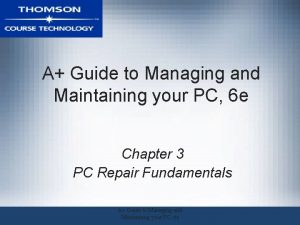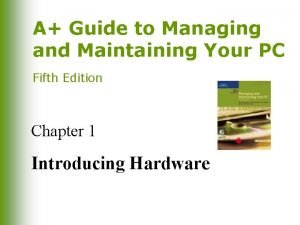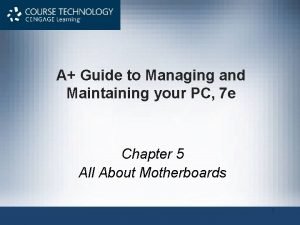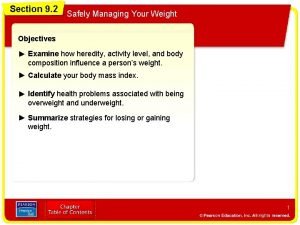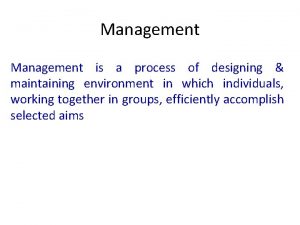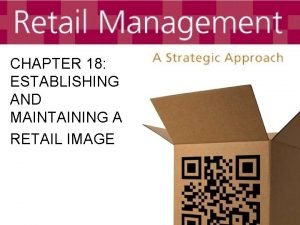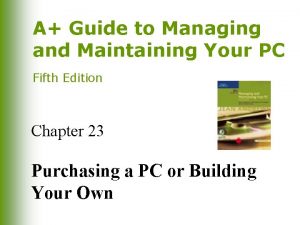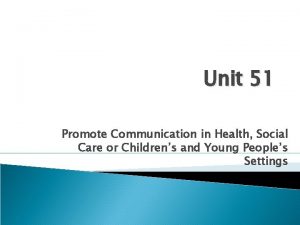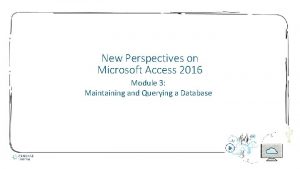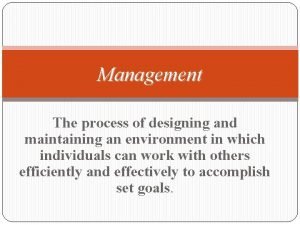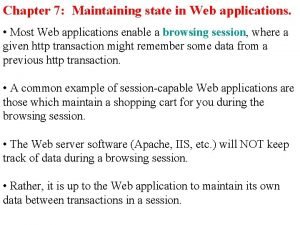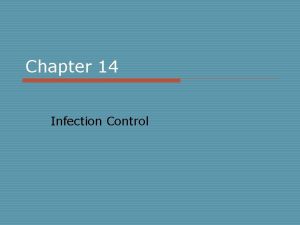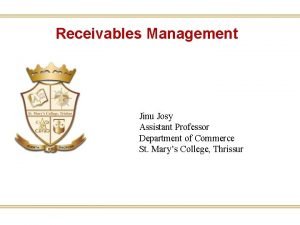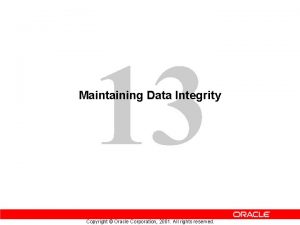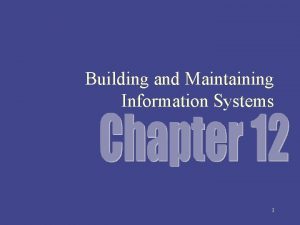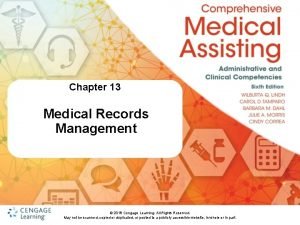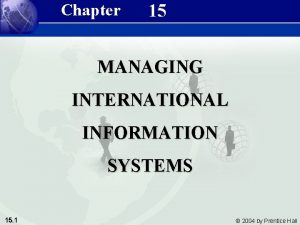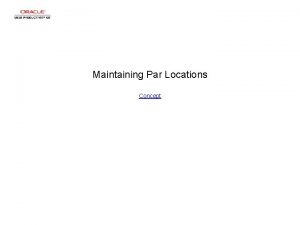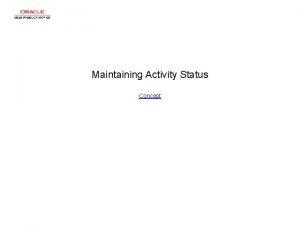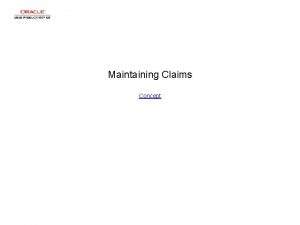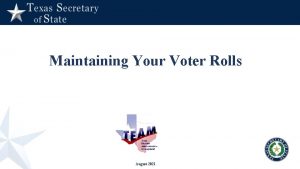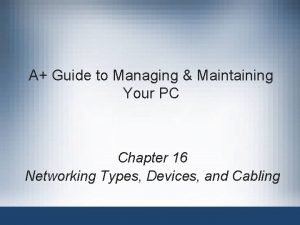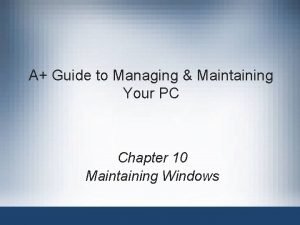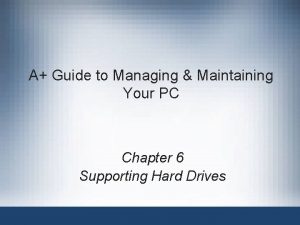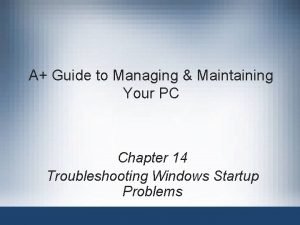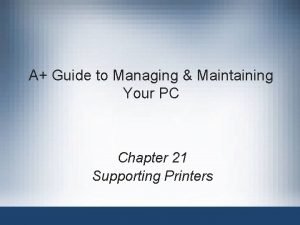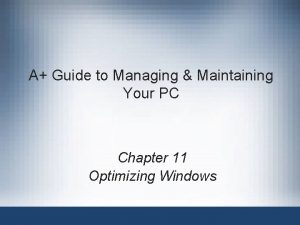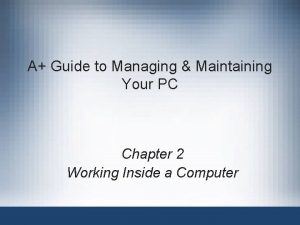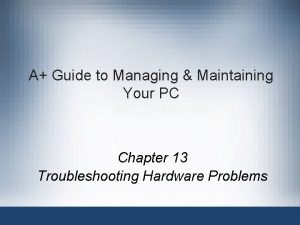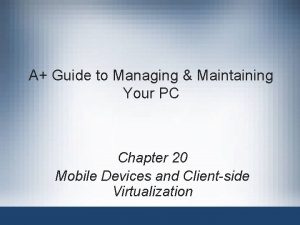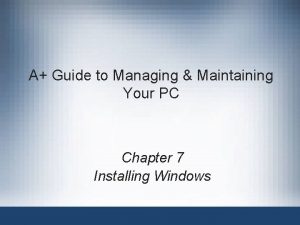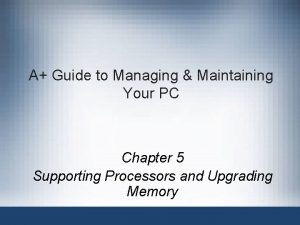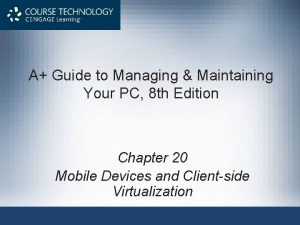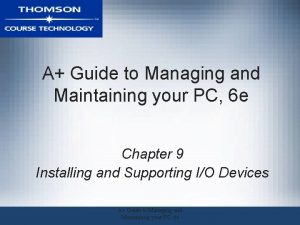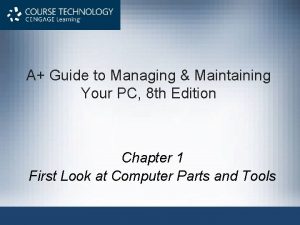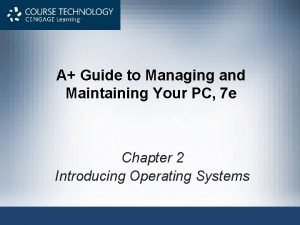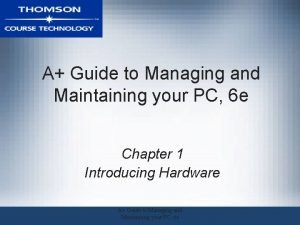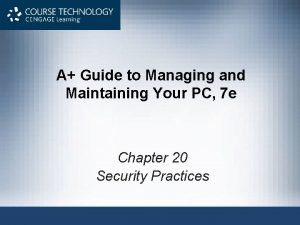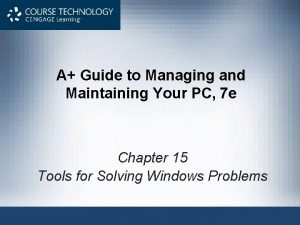A Guide to Managing Maintaining Your PC Chapter







































![TCP/IP Utilities Used For Troubleshooting • Ping [-A] [-T] [TARGETNAME] – Tests connectivity by TCP/IP Utilities Used For Troubleshooting • Ping [-A] [-T] [TARGETNAME] – Tests connectivity by](https://slidetodoc.com/presentation_image_h2/4e355f6cd50e70938ee3398e68c6977d/image-40.jpg)
![TCP/IP Utilities Used For Troubleshooting • IPCONFIG [/ALL] [/RELEASE] [/RENEW] [/DISPLAYDNS] [/FLUSHDNS] – Can TCP/IP Utilities Used For Troubleshooting • IPCONFIG [/ALL] [/RELEASE] [/RENEW] [/DISPLAYDNS] [/FLUSHDNS] – Can](https://slidetodoc.com/presentation_image_h2/4e355f6cd50e70938ee3398e68c6977d/image-41.jpg)
![TCP/IP Utilities Used For Troubleshooting • NSLOOKUP [COMPUTERNAME] – Lets you read information from TCP/IP Utilities Used For Troubleshooting • NSLOOKUP [COMPUTERNAME] – Lets you read information from](https://slidetodoc.com/presentation_image_h2/4e355f6cd50e70938ee3398e68c6977d/image-42.jpg)



![TCP/IP Utilities Used For Troubleshooting • NBTSTAT [-N] [-RR] – Used to display statistics TCP/IP Utilities Used For Troubleshooting • NBTSTAT [-N] [-RR] – Used to display statistics](https://slidetodoc.com/presentation_image_h2/4e355f6cd50e70938ee3398e68c6977d/image-46.jpg)
![TCP/IP Utilities Used For Troubleshooting • NETSTAT [-a] [-b] [-o] – Gives statistics about TCP/IP Utilities Used For Troubleshooting • NETSTAT [-a] [-b] [-o] – Gives statistics about](https://slidetodoc.com/presentation_image_h2/4e355f6cd50e70938ee3398e68c6977d/image-47.jpg)















- Slides: 62

A+ Guide to Managing & Maintaining Your PC Chapter 17 Windows Resources on a Network

Objectives • Learn how to support some client/server applications • Learn how to share and secure files and folders on the network • Learn how to troubleshoot network connections A+ Guide to Managing & Maintaining Your PC, 8 th Edition © Cengage Learning 2014 2

Supporting Client/Server Applications • Client/Server applications expected to support: – Internet Explorer – Remote Desktop – Other remote applications • Also need to know how to configure network settings to improve performance for client/server applications using: – Wake on LAN – Quality of Service techniques – Group Policy A+ Guide to Managing & Maintaining Your PC, 8 th Edition © Cengage Learning 2014 3

Internet Explorer • Most popular client/server applications are a browser and web server • Internet Explorer (IE) version 9: latest version at this writing • Easy to upgrade to latest IE version by using Windows Update • Tips when using IE window: – To show the menu bar, press the Alt key – To get help using IE, press F 1 to open Windows Help and Support A+ Guide to Managing & Maintaining Your PC, 8 th Edition © Cengage Learning 2014 4

Internet Explorer • Use the Internet Options box to manage IE settings – Click Tools icon and click Internet Options • Internet Options box has several tabs with different configuration options and settings • General Tab – Change the home page or add a second home page – Protect your identity and surfing records – Check Delete browsing history on exit if you want your history cleared each time you close IE – Manage IE cache A+ Guide to Managing & Maintaining Your PC, 8 th Edition © Cengage Learning 2014 5

Internet Explorer • Security Tab – Set security level (medium-high is the default level) • Prompts before downloading content • Does not download Active. X controls that are not signed by Microsoft (virus can sometimes hide in an Active. X control) – To customize security settings, click Custom level A+ Guide to Managing & Maintaining Your PC, 8 th Edition © Cengage Learning 2014 6

Internet Explorer • Privacy Tab and Content Tab – Use Privacy Tab to block cookies that might invade your privacy or steal identity – Content tab contains settings for parental controls, allowed content based on ratings, certificates used by web sites, and how Auto. Complete and Feeds are handled A+ Guide to Managing & Maintaining Your PC, 8 th Edition © Cengage Learning 2014 7

Internet Explorer • Connections Tab and Proxy Settings – Allows you to configure proxy server settings and create a VPN connection • Proxy server: intercepts requests that a browser makes of a server and serves up request from a cache it maintains Figure 17 -9 Enter the IP address of all proxy servers on your corporate network A+ Guide to Managing & Maintaining Your PC, 8 th Edition © Cengage Learning 2014 8

Internet Explorer • Programs Tab – Used to manage add-ons • Add-ons: small apps that help IE display multimedia content, manage email, translate text, or other actions Figure 17 -10 Use the Programs Tab to manage add-ons and default applications used for Internet services A+ Guide to Managing & Maintaining Your PC, 8 th Edition © Cengage Learning 2014 9

Internet Explorer • Advanced Tab – Contains several miscellaneous settings used to control Internet Explorer – One setting is useful when IE is giving problems • If you suspect problems are caused by wrong settings, click Reset to return IE to all default settings A+ Guide to Managing & Maintaining Your PC, 8 th Edition © Cengage Learning 2014 10

Remote Desktop • Remote Desktop gives a user access to a Windows desktop from anywhere on the Internet • To use Remote Desktop, the computer you want to remotely access (the server) must be running business or professional editions of Windows 7/Vista/XP – Computer accessing can be running any version of Windows • Computers set to serve up Remote Desktop are not as secure – You can use software that does not require opening ports for a more secure solution A+ Guide to Managing & Maintaining Your PC, 8 th Edition © Cengage Learning 2014 11

Remote Applications • Remote application: installed and executed on a server and is presented to a user working at a client computer • Windows Server includes software to manage remote apps – Remote Desktop Services (Windows Server 2008 and later) – Terminal Services (Windows Server prior to 2008) • Both use RDP protocol to present the remote app and the data to its client A+ Guide to Managing & Maintaining Your PC, 8 th Edition © Cengage Learning 2014 12

Remote Applications • Windows 7 Remote. App and Desktop Connection is used to install the small client program using one of two methods: – System administrator provides an application proxy file – System administrator provides a URL to the server application A+ Guide to Managing & Maintaining Your PC, 8 th Edition © Cengage Learning 2014 13

Network Settings To Support Applications • Wake on LAN – Causes host computer to turn on when a specific type of network activity happens – Even if computer is off, network adapter retains power and listens for network activity • Computer wakes up when adapter receives a specific type of network activity – Two types of activity that can trigger Wake on LAN: • Wake pattern • Magic packet A+ Guide to Managing & Maintaining Your PC, 8 th Edition © Cengage Learning 2014 14

Network Settings To Support Applications • Wake on LAN (cont’d) – System administrator might use utilities to remotely wake a computer to perform routine maintenance – Don’t use Wake on LAN on a laptop • Can drain the battery – Must be supported by your motherboard and network adapter • Must be enabled in both Windows and BIOS setup – Follow steps on pages 379 -380 to enable A+ Guide to Managing & Maintaining Your PC, 8 th Edition © Cengage Learning 2014 15

Figure 17 -22 Use the Power screen in BIOS setup to enable Wake on LAN A+ Guide to Managing & Maintaining Your PC, 8 th Edition © Cengage Learning 2014 16

Network Settings to Support Applications • Quality of Service (Qo. S) – Can improve network performance for an application by raising its priority for allotted network bandwidth – For Windows to enable Qo. S the network adapter must support Qo. S – To configure Windows to provide Qo. S: • Enable Qo. S for the network connection and adapter • Set the Qo. S priority level for applications – Some applications (Microsoft Office 365) have Qo. S priority levels sets automatically – Follow steps on page 380 to enable Qo. S in Windows A+ Guide to Managing & Maintaining Your PC, 8 th Edition © Cengage Learning 2014 17

Use Group Policy to Improve Qo. S Applications • Group Policy (gpedit. msc) – Used to control what users can do and how the system can be used – Only available in Windows professional and business editions – Works by: • Making entries in registry • Applying scripts to Windows startup, shutdown, and logon processes • Affecting security settings A+ Guide to Managing & Maintaining Your PC, 8 th Edition © Cengage Learning 2014 18

Use Group Policy to Improve Qo. S Applications • Group Policy (cont’d) – Can be applied to computer or user • Computer policies are applied just before logon screen • User policies are applied after login – To use Group Policy to set the Qo. S level for an application follow steps on pages 382 -383 – To get the most out of Qo. S, configure each router and computer on the network to use Qo. S A+ Guide to Managing & Maintaining Your PC, 8 th Edition © Cengage Learning 2014 19

Controlling Access to Folders and Files • Managing shared resources is accomplished by: – Assigning rights to user accounts – Assigning permissions to folders and files A+ Guide to Managing & Maintaining Your PC, 8 th Edition © Cengage Learning 2014 20

Classify User Accounts and User Groups • Principle of least privilege: An approach where computer users are assigned the minimum rights required to do their job • Rights or privileges are established when you first create a user account (based on account type) – Rights can later be changed by changing the user groups to which the account belongs • User accounts are created from the Control Panel or by using the Computer Management console A+ Guide to Managing & Maintaining Your PC, 8 th Edition © Cengage Learning 2014 21

Classify User Accounts and User Groups • Type of User Account – Administrator account: has complete access to the system and can make changes that affect the security of the system and other users – Standard user account: can use software and hardware and make some system changes but cannot make changes that affect the security of the system or other users A+ Guide to Managing & Maintaining Your PC, 8 th Edition © Cengage Learning 2014 22

Classify User Accounts and User Groups • Built-in User Groups – Administrators and Users groups – Guests group • Has limited rights and is given a temporary profile that is deleted when user logs off – Backup Operators group • Can back up and restore files on the system regardless of its access permission to files – Power Users group • Windows XP group that can read from and write to parts of the system, install apps, and perform limited administrator tasks A+ Guide to Managing & Maintaining Your PC, 8 th Edition © Cengage Learning 2014 23

Classify User Accounts and User Groups • Windows might automatically assign one of these built-in user groups to an account: – Authenticated Users group: includes all user accounts except the Guest account – Everyone group: includes the Authenticated Users group as well as the Guest account – Anonymous users: users who have not been authenticated on a remote computer A+ Guide to Managing & Maintaining Your PC, 8 th Edition © Cengage Learning 2014 24

Classify User Accounts and User Groups • Customized User Groups – Use Management Console in business and professional editions of Windows to create custom user groups – Easier to assign permissions to user groups rather than to individual accounts • User groups work well when several users need the same permissions • Create a user group and then assign permission to the user group A+ Guide to Managing & Maintaining Your PC, 8 th Edition © Cengage Learning 2014 25

Methods to Assign Permissions To Folders and Files • Three general strategies for managing shared folder and files in Windows – Windows 7 homegroup sharing: use when all users on a network require the same access to all resources – Workgroup sharing: offers better security than a homegroup – Domain controlling: if computer belongs to a domain, all security is managed by the network administrator for the entire network A+ Guide to Managing & Maintaining Your PC, 8 th Edition © Cengage Learning 2014 26

Methods to Assign Permissions To Folders and Files • Tips on which folder to use to hold shared data: – Private data for individual users • C: Users or the XP C: Documents and Settings folder for that user – Data for all users to share • C: UsersPublic folder – For best security, create a folder not in either of the above folders and assign permissions to that folder and its subfolders • Allow all users access or only certain users or user groups A+ Guide to Managing & Maintaining Your PC, 8 th Edition © Cengage Learning 2014 27

Methods to Assign Permissions To Folders and Files • Using workgroup sharing, Windows offers two methods to share a folder – Share permissions: grant permissions only to network users and not to local users • Apply to a folder and its contents, not to individual files – NTFS permissions: apply to local users and network users • Apply to both folders and individual files • Work on NTFS volumes only A+ Guide to Managing & Maintaining Your PC, 8 th Edition © Cengage Learning 2014 28

Methods to Assign Permissions To Folders and Files • Tips when implementing permissions: – If both share and NTFS permission are used, the most restrictive permission applies – If NTFS permissions are conflicting the more liberal permission applies – Permission propagation: when permissions are passed from parent to child – Inherited permissions: permissions attained from a parent object – When you move or copy an object to a folder, the object takes on permissions of that folder A+ Guide to Managing & Maintaining Your PC, 8 th Edition © Cengage Learning 2014 29

How to Share Folders and Files • How to Use Share Permission – For NTFS volume, use NTFS permission whenever possible Figure 17 -41 Use the sharing tab of a folder properties box to set up share permissions A+ Guide to Managing & Maintaining Your PC, 8 th Edition © Cengage Learning 2014 30

Support and Troubleshoot Shared Folders and Files • Few tips about managing shared folders and files: – Use advanced permissions settings if you need further control of a user or group • Click Advanced on the Security tab of a folder’s Properties box – Manage permissions using parent folder • Subfolders inherit permissions of the parent folder – Check the effective permissions • To know for sure which permissions are in effect, see Effective Permissions tab of Advanced Security Settings box A+ Guide to Managing & Maintaining Your PC, 8 th Edition © Cengage Learning 2014 31

Support and Troubleshoot Shared Folders and Files • Few tips about managing shared folders and files: (cont’d) – Take ownership of a folder • Owner of a folder always has full permissions – Use only one workgroup • Performance improves when they are all in the same workgroup – Require passwords for all user accounts – Use a mapped network drive A+ Guide to Managing & Maintaining Your PC, 8 th Edition © Cengage Learning 2014 32

How to Map a Network Drive • A network drive map makes one computer (client) appear to have a new hard drive – Assign a drive letter to a path to a shared folder or drive on another computer • Network File System (NFS) makes it possible for files on the network to be accessed as easily as if they are stored on the local computer A+ Guide to Managing & Maintaining Your PC, 8 th Edition © Cengage Learning 2014 33

Figure 17 -47 Mapping a network drive to a host computer A+ Guide to Managing & Maintaining Your PC, 8 th Edition © Cengage Learning 2014 34

Hidden Network Resources and Administrative Shares • To protect confidential data from users on the network: – Disable File and Printer Sharing – Hide a shared folder • If you want to share a folder, but don’t want others to see it add a $ to the end of the folder name • Those that want to access the hidden folder must enter the complete path to the folder (including $) in search box A+ Guide to Managing & Maintaining Your PC, 8 th Edition © Cengage Learning 2014 35

Hidden Network Resources and Administrative Shares • Local shares: folders and files on a computer that are shared with others using local user accounts • Administrative shares: folders that are shared by default that administrator accounts at the domain level can access – Two types of administrative shares: • The %systemroot% folder • Any volume or drive • Don’t share the /Windows folder or an entire drive – Don’t want system files and folders exposed A+ Guide to Managing & Maintaining Your PC, 8 th Edition © Cengage Learning 2014 36

Troubleshooting Network Connections • Both hardware and software tools can help when troubleshooting network connections • Hardware tools: – Cable tester – Loopback plug – Wireless locator • Windows TCP/IP utilities A+ Guide to Managing & Maintaining Your PC, 8 th Edition © Cengage Learning 2014 37

Cable Tester, Loopback Plug, and Wireless Locator • Cable tester – can be used to: – Test whether a cable is good or not – Find out what type of cable it is – Trace a network cable through a building • Loopback plug – can be used to test a network cable or port – Cable testers work on cables that are not live – Loopback plugs work with live cables and ports – When buying a loopback plug pay attention to Ethernet speeds supported • Some only support 100 Mbps A+ Guide to Managing & Maintaining Your PC, 8 th Edition © Cengage Learning 2014 38

Cable Tester, Loopback Plug, and Wireless Locator • Wireless locator – helps find a Wi-Fi hotspot and measures the strength of an RF signal – Helpful when mapping out where to position a wireless access point – When buying a wireless locator, look for one that tells if the hotspot is encrypted and supports all current Wi. Fi standards A+ Guide to Managing & Maintaining Your PC, 8 th Edition © Cengage Learning 2014 39
![TCPIP Utilities Used For Troubleshooting Ping A T TARGETNAME Tests connectivity by TCP/IP Utilities Used For Troubleshooting • Ping [-A] [-T] [TARGETNAME] – Tests connectivity by](https://slidetodoc.com/presentation_image_h2/4e355f6cd50e70938ee3398e68c6977d/image-40.jpg)
TCP/IP Utilities Used For Troubleshooting • Ping [-A] [-T] [TARGETNAME] – Tests connectivity by sending an echo request to a remote computer Table 8 -2 Examples of the ping command A+ Guide to Managing & Maintaining Your PC, 8 th Edition © Cengage Learning 2014 40
![TCPIP Utilities Used For Troubleshooting IPCONFIG ALL RELEASE RENEW DISPLAYDNS FLUSHDNS Can TCP/IP Utilities Used For Troubleshooting • IPCONFIG [/ALL] [/RELEASE] [/RENEW] [/DISPLAYDNS] [/FLUSHDNS] – Can](https://slidetodoc.com/presentation_image_h2/4e355f6cd50e70938ee3398e68c6977d/image-41.jpg)
TCP/IP Utilities Used For Troubleshooting • IPCONFIG [/ALL] [/RELEASE] [/RENEW] [/DISPLAYDNS] [/FLUSHDNS] – Can display TCP/IP configuration Table 8 -3 Examples of ipconfig command A+ Guide to Managing & Maintaining Your PC, 8 th Edition © Cengage Learning 2014 41
![TCPIP Utilities Used For Troubleshooting NSLOOKUP COMPUTERNAME Lets you read information from TCP/IP Utilities Used For Troubleshooting • NSLOOKUP [COMPUTERNAME] – Lets you read information from](https://slidetodoc.com/presentation_image_h2/4e355f6cd50e70938ee3398e68c6977d/image-42.jpg)
TCP/IP Utilities Used For Troubleshooting • NSLOOKUP [COMPUTERNAME] – Lets you read information from the Internet name space by requesting information about domain name resolutions from the DNS server’s zone data – A reverse lookup is when you use the Nslookup command to find the host name when you know the IP address A+ Guide to Managing & Maintaining Your PC, 8 th Edition © Cengage Learning 2014 42

TCP/IP Utilities Used For Troubleshooting • TRACERT TARGETNAME – Sends a series of requests to the destination computer and displays each hop to the destination • A hop happens when a packet moves from one router to another – A packet is assigned a Time To Live (TTL), which is the number of hop counts it can make before a router drops the packet and sends an ICMP message back to the host that sent packet A+ Guide to Managing & Maintaining Your PC, 8 th Edition © Cengage Learning 2014 43

Figure 17 -58 A router eliminates a packet that has exceeded its TTL A+ Guide to Managing & Maintaining Your PC, 8 th Edition © Cengage Learning 2014 44

TCP/IP Utilities Used For Troubleshooting • The NET Commands – NET command is several commands in one – Most require an elevated command prompt window – Net use command • Connects or disconnects a computer from a shared resource – Net user command • Manages user accounts A+ Guide to Managing & Maintaining Your PC, 8 th Edition © Cengage Learning 2014 45
![TCPIP Utilities Used For Troubleshooting NBTSTAT N RR Used to display statistics TCP/IP Utilities Used For Troubleshooting • NBTSTAT [-N] [-RR] – Used to display statistics](https://slidetodoc.com/presentation_image_h2/4e355f6cd50e70938ee3398e68c6977d/image-46.jpg)
TCP/IP Utilities Used For Troubleshooting • NBTSTAT [-N] [-RR] – Used to display statistics about the Net. BT (Net. BIOS over TCP/IP) protocol • Net. BIOS is an older network protocol suite used before TCP/IP Table 8 -4 Nbtstat commands A+ Guide to Managing & Maintaining Your PC, 8 th Edition © Cengage Learning 2014 46
![TCPIP Utilities Used For Troubleshooting NETSTAT a b o Gives statistics about TCP/IP Utilities Used For Troubleshooting • NETSTAT [-a] [-b] [-o] – Gives statistics about](https://slidetodoc.com/presentation_image_h2/4e355f6cd50e70938ee3398e68c6977d/image-47.jpg)
TCP/IP Utilities Used For Troubleshooting • NETSTAT [-a] [-b] [-o] – Gives statistics about TCP/IP and network activity Table 8 -5 Netstat commands A+ Guide to Managing & Maintaining Your PC, 8 th Edition © Cengage Learning 2014 47

Strategies For Troubleshooting Network Connections • Check for local connectivity – Use Windows Explorer to try to access shared folders on the network • Determine whether other computers on network are having trouble with their connections • If some resources can be accessed, but not all: – Might be caused by cables or a switch on the network • Test for Internet access by opening a browser • Use ipconfig command to check IP addressing – Computer assigns itself an address starting with 169. 254 if it was unable to lease an IP address A+ Guide to Managing & Maintaining Your PC, 8 th Edition © Cengage Learning 2014 48

Problems With No Connectivity or Intermittent Connectivity • Begin by checking hardware and then move on to checking Windows network settings • Check status indicator lights on the NIC or Ethernet port – Steady light indicates connectivity and blinking light indicates activity • Check the network cable connection at both ends • For wireless networking, make sure wireless switch on a laptop is turned on – May need to move laptop to a new position in the hotspot A+ Guide to Managing & Maintaining Your PC, 8 th Edition © Cengage Learning 2014 49

Problems With No Connectivity or Intermittent Connectivity • After checking hardware, try one of the following Windows methods: – In an elevated command prompt, use ipconfig /release followed by ipconfig /renew – In Windows 7 Network and Sharing Center, click a yellow triangle or red X to launch Windows diagnostics – In Vista, open Network and Sharing Center, click Diagnose and repair – In XP Network Connections window, right-click network icon and select Repair A+ Guide to Managing & Maintaining Your PC, 8 th Edition © Cengage Learning 2014 50

Problems With No Connectivity or Intermittent Connectivity • If problem is still not resolved, check NIC drivers: – Check for adapter in Device Manager – If errors are reported with adapter in Device Manager, try updating drivers • If errors still occur, check the manufacturer web site for diagnostic software – Try running antivirus software and updating Windows A+ Guide to Managing & Maintaining Your PC, 8 th Edition © Cengage Learning 2014 51

Problems with Internet Connectivity • If you have local connectivity, but not Internet access: – Try recycling the connection to the ISP • Unplug power source to the cable modem or other device used to connect to ISP to restart • Use Network and Sharing Center, on any computer, to repair the connection – For a cable modem, make sure your TV works – To eliminate router, connect one computer directly to the broadband modem • If you can access the Internet, you have proven router is the problem A+ Guide to Managing & Maintaining Your PC, 8 th Edition © Cengage Learning 2014 52

Problems with Internet Connectivity • No Internet connectivity: (cont’d) – To eliminate DNS as the problem • Substitute a domain name for an IP address in a ping command (If ping works, DNS works) • Ping your DNS server – If having problems reaching a particular website, try using the tracert command • Example: tracert www. course. com – If one computer cannot access Internet but other can, make sure MAC address filtering is disabled A+ Guide to Managing & Maintaining Your PC, 8 th Edition © Cengage Learning 2014 53

Problems with Internet Connectivity • No Internet connectivity: (cont’d) – Verify router firewall or Windows firewall settings – Contact your ISP A+ Guide to Managing & Maintaining Your PC, 8 th Edition © Cengage Learning 2014 54

Use TCP/IP Utilities to Solve Connectivity Problems • Follow these steps to verify the local computer is communicating over the network: – 1. Try to release the current IP address and lease a new address – 2. Ping another computer on the network • Ping a computer on the Internet using its host address – 3. Enter ipconfig /all at a command prompt to verify IP information – 4. Ping the loopback address (127. 0. 0. 1) – 5. Use the netstat –b command to find out if the program to access the network is actually running A+ Guide to Managing & Maintaining Your PC, 8 th Edition © Cengage Learning 2014 55

Use TCP/IP Utilities to Solve Connectivity Problems • Follow these steps to verify the local computer is communicating over the network: (cont’d) – 6. Verify firewall settings are correct – 7. Use the following command to verify that no computers have the same computer name: • Net view \computername – 8. Verify NTFS permissions and share settings on any computer that can be pinged but no found through Windows Explorer – 9. Use the following command to view list of shared folders on a remote computer: • Net view \computername A+ Guide to Managing & Maintaining Your PC, 8 th Edition © Cengage Learning 2014 56

Use TCP/IP Utilities to Solve Connectivity Problems • Follow these steps to verify the local computer is communicating over the network: (cont’d) – 10. If the net view command using a computer name does not work, try the command using an IP address • Net view 192. 168. 1. 102 – 11. If you’re having problems getting a network drive map to work, try making the connection with the net use command • Net use z: \computernamefolder • To disconnect a mapped network drive: net use z: /delete A+ Guide to Managing & Maintaining Your PC, 8 th Edition © Cengage Learning 2014 57

Use TCP/IP Utilities to Solve Connectivity Problems • For slow network connections, try: – 1. If a computer uses both a wireless and wired connection you can control the priority order of the connections • Use the Networking tab of Task Manager to see the priority order and find out which connection is faster – 2. To change the priority order, open Network and Sharing Center and click Change adapter settings • Press Alt to display menu bar, click Advanced and Advanced Settings • Select the connection you want to move up in the priority order and click green up arrow A+ Guide to Managing & Maintaining Your PC, 8 th Edition © Cengage Learning 2014 58

Figure 17 -65 Change the priority order of the network connections A+ Guide to Managing & Maintaining Your PC, 8 th Edition © Cengage Learning 2014 59

Chapter Summary • The Internet Options dialog box is used to manage many Internet Explorer settings • Remote Desktop gives you access to your Windows desktop from anywhere on the Internet • Configure the Windows network adapter properties and BIOS setup to use Wake on LAN • A policy can be set using Group Policy to improve Qo. S for an application • Controlling access to folders and files on a network is done by assigning rights to user accounts and assigning permissions to files and folders A+ Guide to Managing & Maintaining Your PC, 8 th Edition © Cengage Learning 2014 60

Chapter Summary • Apply the principle of least privilege when assigning rights to users • Three ways to share files and folder on a network are to use homegroup sharing, workgroup sharing, and domain controllers • A mapped network drive makes it easier for users to access drives and folders on the network • Cable testers, loopback plugs, and wireless locators are used to troubleshoot hardware connection problems A+ Guide to Managing & Maintaining Your PC, 8 th Edition © Cengage Learning 2014 61

Chapter Summary • Useful Windows TCP/IP utilities are ping, ipconfig, nslookup, tracert, net user, nbtstat, and netstat • When troubleshooting network problems, check hardware, device drivers, Windows, and client/server applications, in that order A+ Guide to Managing & Maintaining Your PC, 8 th Edition © Cengage Learning 2014 62
 Guide to managing and maintaining your pc
Guide to managing and maintaining your pc Guide to managing and maintaining your pc
Guide to managing and maintaining your pc Guide to managing and maintaining your pc
Guide to managing and maintaining your pc Serve as your guide in managing your enterprise
Serve as your guide in managing your enterprise Chapter 17 owning and maintaining a car
Chapter 17 owning and maintaining a car Scriptures to maintain deliverance
Scriptures to maintain deliverance Chapter 16 managing the stress in your life
Chapter 16 managing the stress in your life Chapter 15 infection control
Chapter 15 infection control Chapter 11 managing weight and eating behaviors
Chapter 11 managing weight and eating behaviors Give us your hungry your tired your poor
Give us your hungry your tired your poor Managing your personal finances textbook answers
Managing your personal finances textbook answers Managing your online identity
Managing your online identity Managing your payables
Managing your payables Managing your weight part 2
Managing your weight part 2 Maintenance of records and reports in obg
Maintenance of records and reports in obg The process of designing and maintaining an environment
The process of designing and maintaining an environment Building and maintaining a website
Building and maintaining a website Cleaning equipment for crockery
Cleaning equipment for crockery Disadvantages of straight traffic pattern
Disadvantages of straight traffic pattern Elements of retail image
Elements of retail image Maintaining a healthy body composition and body image
Maintaining a healthy body composition and body image Maintaining a professional image
Maintaining a professional image Class-maintaining prefixes examples
Class-maintaining prefixes examples Vision focuses on the current reality and maintaining it
Vision focuses on the current reality and maintaining it Purchasing and maintaining a computer
Purchasing and maintaining a computer Potential tension between maintaining confidentiality
Potential tension between maintaining confidentiality Characteristics of a teachable spirit
Characteristics of a teachable spirit Maintaining a website
Maintaining a website Access module 3 maintaining a database
Access module 3 maintaining a database The process of designing and maintaining an environment
The process of designing and maintaining an environment Kohlberg's stages of moral development
Kohlberg's stages of moral development Maintaining effective partnerships
Maintaining effective partnerships Maintaining state in web applications
Maintaining state in web applications Maintaining transmission based isolation precautions
Maintaining transmission based isolation precautions Maintaining ecological balance
Maintaining ecological balance Cost of maintaining receivables
Cost of maintaining receivables Homeostasis blood calcium level
Homeostasis blood calcium level Maintaining a healthy body composition and body image
Maintaining a healthy body composition and body image Maintaining student privacy
Maintaining student privacy Building and maintaining customer relationships
Building and maintaining customer relationships Is the way you see your body.
Is the way you see your body. Data integrity in oracle
Data integrity in oracle Maintaining curiosity
Maintaining curiosity Maintaining a healthy body composition and body image
Maintaining a healthy body composition and body image Maintaining information systems
Maintaining information systems Chapter 1 managing risk when driving
Chapter 1 managing risk when driving Chapter 8 managing stress and anxiety
Chapter 8 managing stress and anxiety Leasiest
Leasiest When a person continually looks all around the scene
When a person continually looks all around the scene Chapter 8 managing distractions answers
Chapter 8 managing distractions answers Chapter 6 managing weight and body composition
Chapter 6 managing weight and body composition What is the ipde process
What is the ipde process What is the ipde process
What is the ipde process Chapter 4 lesson 2 managing stress answer key
Chapter 4 lesson 2 managing stress answer key Explain what is meant by selective use of the ipde process
Explain what is meant by selective use of the ipde process Managing in a global environment
Managing in a global environment Chapter 18 managing anxiety
Chapter 18 managing anxiety Chapter 17 managing personal finances
Chapter 17 managing personal finances Ch 17 mini sim on managing business finances
Ch 17 mini sim on managing business finances Managing medical records chapter 13
Managing medical records chapter 13 Chapter 11 managing weight and eating behaviors
Chapter 11 managing weight and eating behaviors Managing global systems chapter 15
Managing global systems chapter 15 Management chapter 1
Management chapter 1
